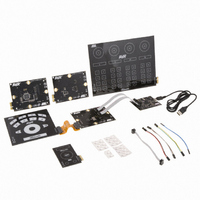ATQT600 Atmel, ATQT600 Datasheet - Page 67

ATQT600
Manufacturer Part Number
ATQT600
Description
KIT EVAL TOUCH FOR QT600
Manufacturer
Atmel
Series
QTouch™r
Specifications of ATQT600
Sensor Type
Touch Screen
Interface
USB
Embedded
Yes, Other
Utilized Ic / Part
ATtiny88, ATmega324PA, ATxmega128A1
Processor To Be Evaluated
ATtiny88, ATmega324, ATxmega128
Data Bus Width
8 bit, 16 bit
Interface Type
USB
Maximum Operating Temperature
+ 85 C
Minimum Operating Temperature
- 40 C
Operating Supply Voltage
1.6 V to 3.6 V
Silicon Manufacturer
Atmel
Kit Application Type
Sensor
Application Sub Type
Touch Sensor
Kit Contents
USB Bridge, MCU Cards, Touchpad Cards
Svhc
No SVHC (15-Dec-2010)
Mcu Supported Families
ATtiny88,
Rohs Compliant
Yes
Lead Free Status / RoHS Status
Lead free / RoHS Compliant
Voltage - Supply
-
Sensitivity
-
Sensing Range
-
Lead Free Status / Rohs Status
Lead free / RoHS Compliant
Available stocks
Company
Part Number
Manufacturer
Quantity
Price
Company:
Part Number:
ATQT600
Manufacturer:
Atmel
Quantity:
135
Touch Sensors Design Guide
Channel
Electrode
False Touch
Hand Shadow
Jitter
Key
Line
1. Sometimes called Bell-shaped or Normal distribution.
One of the capacitive measurement point at which the sensor controller can detect capacitive
change.
See also node.
The patch of conductive material on the substrate that forms the sensor. An electrode is usually (but
not always) made from copper, carbon, silver ink, Orgacon™ or Indium Tin Oxide (ITO).
An unexpected key detection caused by an interaction of the Y traces with the X traces. False
touches can occur anywhere that X and Y are too close and the field between them is allowed to be
influenced by touch. See
The situation in which a false touch is detected from the user’s hand as it is held over a sensor, rather
than from the user’s finger. This effect occurs when a sensor is particularly large in proportion to a
hand. It is a particular problem for large self-capacitance sliders and wheels. See
page
The peak-to-peak variance in the reported location for an axis when a fixed touch is applied. Typically
jitter is random in nature and has a Gaussian
jitter must be conducted over some period of time, typically a few seconds. Jitter is typically
measured as a percentage of the axis in question.
For example a 100 x 100 mm touchscreen that shows ±0.5 percent jitter in X and ±1 percent jitter in
Y would show a peak deviation from the average reported coordinate of ±0.5 mm in X and ±1 mm in
Y. Note that by defining the jitter relative to the average reported coordinate, effects of linearity are
ignored.
A simple zero-dimensional electrode arrangement whose capacitance changes when touched,
allowing touched or not-touched status (on or off) detection.
The logical X or Y line used for the detection of touches, as opposed to a physical trace.
5-2.
Section on page
4-7.
(1)
distribution, therefore measurement of peak-to-peak
Glossary of Terms
Appendix A
Section 5.2.3 on
10620D–AT42–04/09
A-1













